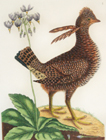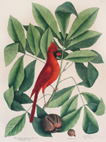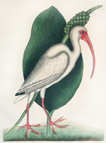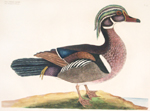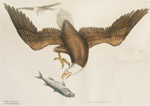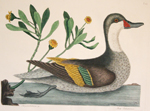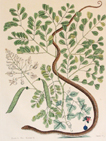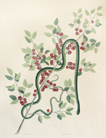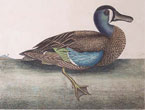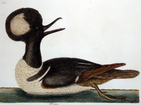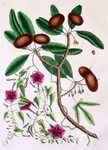
 |
(Click images to enlarge and for purchase information.) Want to know more about prints? |
|
Prints are from The Natural History of Carolina, Florida and the Bahama Islands (1731 & 1771 Editions) and are approximately Folio approx. 14" x 21" in size.
Catesby’s visit, which included a trip to the West Indies in 1714, lasted seven years. During this time he collected and shipped seeds and botanical specimens to England and observed and noted American birds and thus became known in British scientific circles. Later, when the most prestigious English scientific body, the Royal Society, organized a plant collecting expedition to Carolina, Catesby was recommended. William Sherad, a wealthy patron of Natural History, who founded the Chair of Botany at Oxford University, suggested Catesby “as a man pretty well skilled in Natural History designs and paints in watercolours to perfection.”Catesby returned to America in 1722 under the patronage of Sherad and Sir Hans Sloane, whose extensive Natural History collection formed the basis for the British Museum. During the four years he spent in Charles Town (Charleston, South Carolina) he collected seeds, plants, animals, fishes, turtles, snakes and birds. One of his letters from Charles Town dated 15 November, 1723 states, “I hope you have received the remains of a cargo of plants, birds, shells, etc., which fel into the hands of pirats.” Catesby preserved his birds by keeping them in alcohol or drying them slowly in an oven and then stuffing them. The stuffed birds were then sprinkled with tobacco dust to deter insects and retain the freshness of the plumage color. These preserved specimens and his own field sketches from living birds were the only evidence he had when he returned to England in 1726 to begin work on his opus, The Natural History of Carolina, Florida and the Bahama Islands, containing the Figures of Birds, Beasts, Fishes, Serpents, Insects and Plants, Particularly Those Not Hitherto Described, or Incorrectly Figured by Former Authors, with their Descriptions in English and French. Mark Catesby, too poor by this time to engage a professional engraver, etched his own copperplates for the reproduction of his splendid drawings. To supply a mere one hundred copies of his first volume, finished in 1732, required pulling ten thousand etchings from his 100 painstakingly prepared copperplates, then watercoloring by hand each leaf, flower and bird on each of these ten thousand plates! He labored on until 1746 when the 220th and final plate was printed. Reissued in 1754 and 1771, this great work was the first comprehensive study of American Flora and Fauna. |
||

